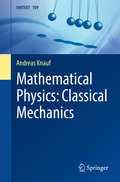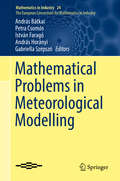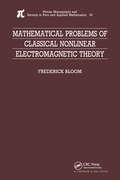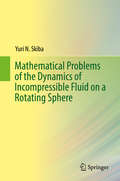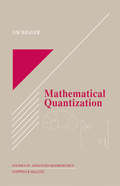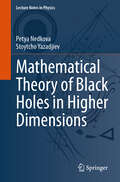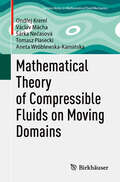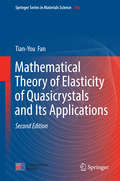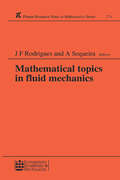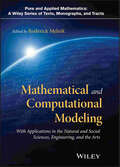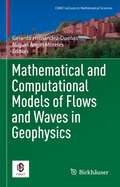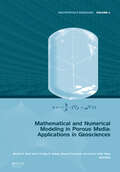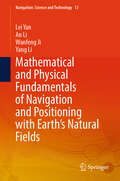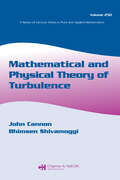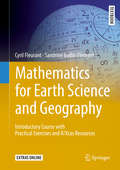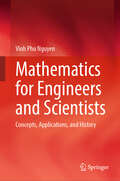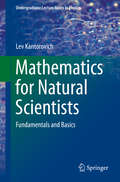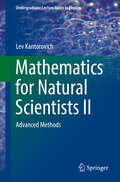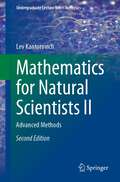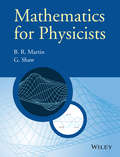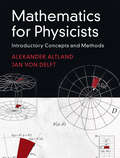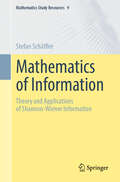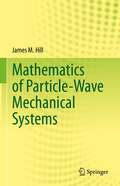- Table View
- List View
Mathematical Physics: Classical Mechanics (UNITEXT #109)
by Andreas Knauf Jochen DenzlerAs a limit theory of quantum mechanics, classical dynamics comprises a large variety of phenomena, from computable (integrable) to chaotic (mixing) behavior. This book presents the KAM (Kolmogorov-Arnold-Moser) theory and asymptotic completeness in classical scattering. Including a wealth of fascinating examples in physics, it offers not only an excellent selection of basic topics, but also an introduction to a number of current areas of research in the field of classical mechanics. Thanks to the didactic structure and concise appendices, the presentation is self-contained and requires only knowledge of the basic courses in mathematics.The book addresses the needs of graduate and senior undergraduate students in mathematics and physics, and of researchers interested in approaching classical mechanics from a modern point of view.
Mathematical Problems in Meteorological Modelling
by István Faragó András Bátkai Petra Csomós András Horányi Gabriella SzépszóThis book deals with mathematical problems arising in the context of meteorological modelling. It gathers and presents some of the most interesting and important issues from the interaction of mathematics and meteorology. It is unique in that it features contributions on topics like data assimilation, ensemble prediction, numerical methods, and transport modelling, from both mathematical and meteorological perspectives. The derivation and solution of all kinds of numerical prediction models require the application of results from various mathematical fields. The present volume is divided into three parts, moving from mathematical and numerical problems through air quality modelling, to advanced applications in data assimilation and probabilistic forecasting. The book arose from the workshop "Mathematical Problems in Meteorological Modelling" held in Budapest in May 2014 and organized by the ECMI Special Interest Group on Numerical Weather Prediction. Its main objective is to highlight the beauty of the development fields discussed, to demonstrate their mathematical complexity and, more importantly, to encourage mathematicians to contribute to the further success of such practical applications as weather forecasting and climate change projections. Written by leading experts in the field, the book provides an attractive and diverse introduction to areas in which mathematicians and modellers from the meteorological community can cooperate and help each other solve the problems that operational weather centres face, now and in the near future. Readers engaged in meteorological research will become more familiar with the corresponding mathematical background, while mathematicians working in numerical analysis, partial differential equations, or stochastic analysis will be introduced to further application fields of their research area, and will find stimulation and motivation for their future research work.
Mathematical Problems of Classical Nonlinear Electromagnetic Theory (Monographs And Surveys In Pure And Applied Mathematics Ser. #Vol. 63)
by Frederick BloomA survey of some problems of current interest in the realm of classical nonlinear electromagnetic theory.
Mathematical Problems of the Dynamics of Incompressible Fluid on a Rotating Sphere
by Yuri N. SkibaThis book presents selected mathematical problems involving the dynamics of a two-dimensional viscous and ideal incompressible fluid on a rotating sphere. In this case, the fluid motion is completely governed by the barotropic vorticity equation (BVE), and the viscosity term in the vorticity equation is taken in its general form, which contains the derivative of real degree of the spherical Laplace operator.This work builds a bridge between basic concepts and concrete outcomes by pursuing a rich combination of theoretical, analytical and numerical approaches, and is recommended for specialists developing mathematical methods for application to problems in physics, hydrodynamics, meteorology and geophysics, as well for upper undergraduate or graduate students in the areas of dynamics of incompressible fluid on a rotating sphere, theory of functions on a sphere, and flow stability.
Mathematical Quantization (Studies in Advanced Mathematics)
by Nik WeaverWith a unique approach and presenting an array of new and intriguing topics, Mathematical Quantization offers a survey of operator algebras and related structures from the point of view that these objects are quantizations of classical mathematical structures. This approach makes possible, with minimal mathematical detail, a unified treatment of a
Mathematical Theory of Black Holes in Higher Dimensions (Lecture Notes in Physics #1031)
by Petya Nedkova Stoytcho YazadjievThis book portraits the mathematical theory which lies behind black hole solutions in spacetimes with an extra dimension. Step by step the authors build a comprehensive picture of the main concepts and tools necessary to understand these geometries. In this way the book addresses questions like: How do we describe black holes in higher dimensions? How can we construct such geometries explicitly as exact solutions to the field equations? How many independent solutions can exist and how are they classified?The book concentrates on five-dimensional stationary and axisymmetric spacetimes in electro-vacuum and systematically introduces the most important black geometries which can arise in these settings. The authors follow the natural progress of the research area by initially describing the first results that were obtained intuitively and sparkled interest in the community. Then the elaborate mathematical techniques are introduced which allow to systematically construct exact black hole solutions. Topics like the integrability of the theory, the hidden symmetries of the field equations, the available Bäcklund transformations and solution generation techniques based on the inverse scattering method are covered. The last part of the book is devoted to uniqueness theorems showing how to classify the black hole spacetimes and distinguish the non-equivalent ones.The book is not just a mere collection of facts but a methodological description of the most important mathematical techniques and constructions in an active research area. The discussion is pedagogical and all the methods are demonstrated on a variety of examples. Most of the book is adapted to the level of a graduate student possessing a basic knowledge of general relativity and differential equations, and can serve as a practical guide for quickly acquiring the specific concepts and calculation techniques. Both authors have contributed to the research area by their original results, and share their own experience and perspective.
Mathematical Theory of Compressible Fluids on Moving Domains (Advances in Mathematical Fluid Mechanics)
by Šárka Nečasová Aneta Wróblewska-Kamińska Ondřej Kreml Václav Mácha Tomasz PiaseckiThis monograph presents the existence and properties of both weak and strong solutions to the problems of the flow of a compressible fluid in a domain whose motion is prescribed. Chapters build upon the research of Lions and Feireisl with regards to weak solutions to the compressible version of the Navier-Stokes system, and extend it to problems on moving domains. The authors also show the existence of strong solutions to the compressible Navier-Stokes system for either a small time interval or small data. The opening chapters introduce the notation, tools, and problems covered in the rest of the book, emphasizing pedagogy and accessibility throughout. Mathematical Theory of Compressible Fluids on Moving Domains will be suitable for graduate students and researchers interested in mathematical fluid mechanics.
Mathematical Theory of Elasticity of Quasicrystals and Its Applications
by Tian-You FanThis interdisciplinary work on condensed matter physics, the continuum mechanics of novel materials, and partial differential equations, discusses the mathematical theory of elasticity and hydrodynamics of quasicrystals, as well as its applications. By establishing new partial differential equations of higher order and their solutions under complicated boundary value and initial value conditions, the theories developed here dramatically simplify the solution of complex elasticity problems. Comprehensive and detailed mathematical derivations guide readers through the work. By combining theoretical analysis and experimental data, mathematical studies and practical applications, readers will gain a systematic, comprehensive and in-depth understanding of condensed matter physics, new continuum mechanics and applied mathematics. This new edition covers the latest developments in quasicrystal studies. In particular, it pays special attention to the hydrodynamics, soft-matter quasicrystals, and the Poisson bracket method and its application in deriving hydrodynamic equations. These new sections make the book an even more useful and comprehensive reference guide for researchers working in Condensed Matter Physics, Chemistry and Materials Science.
Mathematical Thermodynamics of Complex Fluids: Cetraro, Italy 2015 (Lecture Notes in Mathematics #2200)
by Eduard Feireisl Elisabetta Rocca John M. Ball Felix OttoEduard FeireislThe main goal of this book is to provide an overview of the state of the art in the mathematical modeling of complex fluids, with particular emphasis on its thermodynamical aspects. The central topics of the text, the modeling, analysis and numerical simulation of complex fluids, are of great interest and importance both for the understanding of various aspects of fluid dynamics and for its applications to special real-world problems. New emerging trends in the subject are highlighted with the intent to inspire and motivate young researchers and PhD students.
Mathematical Topics in Fluid Mechanics: Proceedings Of The Summer Course Held In Lisbon, Portugal, September 9-13, 1991 (Pitman Research Notes In Mathematics Ser.)
by Jose Francisco Rodrigues Adelia SequeiraThis Research Note presents several contributions and mathematical studies in fluid mechanics, namely in non-Newtonian and viscoelastic fluids and on the Navier-Stokes equations in unbounded domains. It includes review of the mathematical analysis of incompressible and compressible flows and results in magnetohydrodynamic and electrohydrodynamic stability and thermoconvective flow of Boussinesq-Stefan type. These studies, along with brief communications on a variety of related topics comprise the proceedings of a summer course held in Lisbon, Portugal in 1991. Together they provide a set of comprehensive survey and advanced introduction to problems in fluid mechanics and partial differential equations.
Mathematical and Computational Modeling
by Roderick MelnikIllustrates the application of mathematical and computational modeling in a variety of disciplines With an emphasis on the interdisciplinary nature of mathematical and computational modeling, Mathematical and Computational Modeling: With Applications in the Natural and Social Sciences, Engineering, and the Arts features chapters written by well-known, international experts in these fields and presents readers with a host of state-of-the-art achievements in the development of mathematical modeling and computational experiment methodology. The book is a valuable guide to the methods, ideas, and tools of applied and computational mathematics as they apply to other disciplines such as the natural and social sciences, engineering, and technology. Mathematical and Computational Modeling: With Applications in the Natural and Social Sciences, Engineering, and the Arts also features: Rigorous mathematical procedures and applications as the driving force behind mathematical innovation and discovery Numerous examples from a wide range of disciplines to emphasize the multidisciplinary application and universality of applied mathematics and mathematical modeling Original results on both fundamental theoretical and applied developments in diverse areas of human knowledge Discussions that promote interdisciplinary interactions between mathematicians, scientists, and engineers Mathematical and Computational Modeling: With Applications in the Natural and Social Sciences, Engineering, and the Arts is an ideal resource for professionals in various areas of mathematical and statistical sciences, modeling and simulation, physics, computer science, engineering, biology and chemistry, industrial, and computational engineering. The book also serves as an excellent textbook for graduate courses in mathematical modeling, applied mathematics, numerical methods, operations research, and optimization.
Mathematical and Computational Models of Flows and Waves in Geophysics (CIMAT Lectures in Mathematical Sciences)
by Gerardo Hernández-Dueñas Miguel Angel MorelesThis volume proposes an integral approach to studying the geophysics of Earth. It is motivated by a variety of phenomena from nature with deep and direct impacts in our lives. Such events may evolve across a large range of spatial and time scales and may be observed in the ocean, the atmosphere, the volcanic surface as well as underground.The physical laws dictating the evolution of such phenomena lead to the unifying theme of this manuscript, that is, the mathematical and computational modeling of flows and waves. Consequently, the underlying models are given in terms of Partial Differential Equations (PDEs) whose solutions are approximated using numerical methods, thus providing simulations of the aforementioned phenomena, as well as the appropriate geophysical validation and interpretation.
Mathematical and Numerical Modeling in Porous Media: Applications in Geosciences (Multiphysics Modeling)
by Martín A. Díaz Viera Pratap N. Sahay Theo M. Nieuwenhuizen Manuel Coronado Arturo Ortiz TapiaPorous media are broadly found in nature and their study is of high relevance in our present lives. In geosciences porous media research is fundamental in applications to aquifers, mineral mines, contaminant transport, soil remediation, waste storage, oil recovery and geothermal energy deposits. Despite their importance, there is as yet no complete
Mathematical and Physical Fundamentals of Navigation and Positioning with Earth's Natural Fields (Navigation: Science and Technology #13)
by An Li Yang Li Lei Yan Wanfeng JiThis book covers various fields relevant to navigation, including Earth's magnetic field, gravity field, topography, celestial polarization field, electrostatic field, and relativistic celestial field effects. It introduces the principles and applications of navigation positioning using various natural field navigation and terrain-assisted methods, including gravity field navigation positioning, geomagnetic field navigation positioning, terrain-assisted navigation positioning, polarization field navigation positioning, electrostatic field navigation positioning, and relativistic effect verification. This book comprehensively introduces the algorithm principles and engineering implementation approaches, providing basic theoretical support for precision navigation positioning and deep space exploration. Based on the principles of gravity, geomagnetic, and terrain-assisted navigation positioning, corresponding to the universal gravitational force and Earth's rotation in Newtonian mechanics, it combines polarization field navigation positioning with the energy field effect of solar incident light waves, as well as electrostatic field navigation positioning with relativistic effect verification. This forms a relatively complete theoretical technical system and abstracts the mathematical essence of each link in the geomagnetic, gravity, and terrain navigation positioning systems. Taking mechanism exploration and algorithm implementation as the basic approach, it has confirmed the theoretical correctness and practical feasibility of natural field navigation positioning through verification with actual measurement data. This book is mainly targeted at professionals, researchers, students, and readers interested in deep space, deep Earth, deep sea, and polar exploration, as well as those working in the field of navigation positioning. It is of reference value in deep space, deep Earth, and deep sea exploration.
Mathematical and Physical Theory of Turbulence, Volume 250 (Lecture Notes in Pure and Applied Mathematics)
by John Cannon Bhimsen ShivamoggiAlthough the current dynamical system approach offers several important insights into the turbulence problem, issues still remain that present challenges to conventional methodologies and concepts. These challenges call for the advancement and application of new physical concepts, mathematical modeling, and analysis techniques. Bringing together ex
Mathematics for Earth Science and Geography: Introductory Course With Practical Exercises And R/xcas Resources (Springer Textbooks In Earth Sciences, Geography And Environment Ser.)
by Cyril Fleurant Sandrine Bodin-FleurantThis undergraduate textbook presents a unique comprehensive overview on Mathematics in Earth Sciences and Geography. It deals with fundamental theoretical and applied mathematics, needed by bachelor students in a wide range of subjects. The book is illustrated with many examples and over a hundred practical exercises, with solutions included in the book. In addition, this textbook highlights numerical resources by using two free software packages (R and Xcas) and introducing their use.
Mathematics for Engineers and Scientists: Concepts, Applications, and History
by Vinh Phu NguyenA majority of mathematics textbooks are written in a rigorous, concise, dry, and boring way. On the other hands, there exist excellent, engaging, fun-to-read popular math books. The problem with these popular books is the lack of mathematics itself. This book is a blend of both. It provides a mathematics book to read, to engage with, and to understand the whys — the story behind the theorems. Written by an engineer, not a mathematician, who struggled to learn math in high school and in university, this book explains in an informal voice the mathematics that future and current engineering and science students need to acquire. If we learn math to understand it, to enjoy it, not to pass a test or an exam, we all learn math better and there is no such a thing that we call math phobia. With a slow pace and this book, everyone can learn math and use it, as the author did at the age of 40 and with a family to take care of.
Mathematics for Natural Scientists
by Lev KantorovichThis book covers a course of mathematics designed primarily for physics and engineering students. It includes all the essential material on mathematical methods, presented in a form accessible to physics students, avoiding precise mathematical jargon and proofs which are comprehensible only to mathematicians. Instead, all proofs are given in a form that is clear and convincing enough for a physicist. Examples, where appropriate, are given from physics contexts. Both solved and unsolved problems are provided in each section of the book. Mathematics for Natural Scientists: Fundamentals and Basics is the first of two volumes. Advanced topics and their applications in physics are covered in the second volume.
Mathematics for Natural Scientists II
by Lev KantorovichThis book covers the advanced mathematical techniques useful for physics and engineering students, presented in a form accessible to physics students, avoiding precise mathematical jargon and laborious proofs. Instead, all proofs are given in a simplified form that is clear and convincing for a physicist. Examples, where appropriate, are given from physics contexts. Both solved and unsolved problems are provided in each chapter. Mathematics for Natural Scientists II: Advanced Methods is the second of two volumes. It follows the first volume on Fundamentals and Basics.
Mathematics for Natural Scientists II: Advanced Methods (Undergraduate Lecture Notes in Physics)
by Lev KantorovichThis textbook, the second in a series (the first covered fundamentals and basics), seeks to make its material accessible to physics students. Physics/engineering can be greatly enhanced by knowledge of advanced mathematical techniques, but the math-specific jargon and laborious proofs can be off-putting to students not well versed in abstract math. This book uses examples and proofs designed to be clear and convincing from the context of physics, as well as providing a large number of both solved and unsolved problems in each chapter. This is the second edition, and it has been significantly revised and enlarged, with Chapters 1 (on linear algebra) and 2 (on the calculus of complex numbers and functions) having been particularly expanded. The enhanced topics throughout the book include: vector spaces, general (non-Hermitian, including normal and defective) matrices and their right/left eigenvectors/values, Jordan form, pseudoinverse, linearsystems of differential equations, Gaussian elimination, fundamental theorem of algebra, convergence of a Fourie series and Gibbs-Wilbraham phenomenon, careful derivation of the Fourier integral and of the inverse Laplace transform. New material has been added on many physics topics meant to illustrate the maths, such as 3D rotation, properties of the free electron gas, van Hove singularities, and methods for both solving PDEs with a Fourier transform and calculating the width of a domain wall in a ferromagnet, to mention just a few. This textbook should prove invaluable to all of those with an interest in physics/engineering who have previously experienced difficulty processing the math involved.
Mathematics for Physicists
by Brian R. Martin Graham P. ShawMathematics for Physicists is a relatively short volume covering all the essential mathematics needed for a typical first degree in physics, from a starting point that is compatible with modern school mathematics syllabuses. Early chapters deliberately overlap with senior school mathematics, to a degree that will depend on the background of the individual reader, who may quickly skip over those topics with which he or she is already familiar. The rest of the book covers the mathematics that is usually compulsory for all students in their first two years of a typical university physics degree, plus a little more. There are worked examples throughout the text, and chapter-end problem sets. Mathematics for Physicists features: Interfaces with modern school mathematics syllabuses All topics usually taught in the first two years of a physics degree Worked examples throughout Problems in every chapter, with answers to selected questions at the end of the book and full solutions on a website This text will be an excellent resource for undergraduate students in physics and a quick reference guide for more advanced students, as well as being appropriate for students in other physical sciences, such as astronomy, chemistry and earth sciences.
Mathematics for Physicists: Introductory Concepts and Methods
by Alexander Altland Jan Von DelftThis textbook is a comprehensive introduction to the key disciplines of mathematics - linear algebra, calculus, and geometry - needed in the undergraduate physics curriculum. Its leitmotiv is that success in learning these subjects depends on a good balance between theory and practice. Reflecting this belief, mathematical foundations are explained in pedagogical depth, and computational methods are introduced from a physicist's perspective and in a timely manner. This original approach presents concepts and methods as inseparable entities, facilitating in-depth understanding and making even advanced mathematics tangible. The book guides the reader from high-school level to advanced subjects such as tensor algebra, complex functions, and differential geometry. It contains numerous worked examples, info sections providing context, biographical boxes, several detailed case studies, over 300 problems, and fully worked solutions for all odd-numbered problems. An online solutions manual for all even-numbered problems will be made available to instructors.
Mathematics for Physics
by Michael Stone Paul GoldbartAn engagingly-written account of mathematical tools and ideas, this book provides a graduate-level introduction to the mathematics used in research in physics. The first half of the book focuses on the traditional mathematical methods of physics - differential and integral equations, Fourier series and the calculus of variations. The second half contains an introduction to more advanced subjects, including differential geometry, topology and complex variables. The authors' exposition avoids excess rigor whilst explaining subtle but important points often glossed over in more elementary texts. The topics are illustrated at every stage by carefully chosen examples, exercises and problems drawn from realistic physics settings. These make it useful both as a textbook in advanced courses and for self-study.
Mathematics of Information: Theory and Applications of Shannon-Wiener Information (Mathematics Study Resources #9)
by Stefan SchäfflerStarting with the Shannon-Wiener approach to mathematical information theory, allowing a mathematical "measurement" of an amount of information, the book begins by defining the terms message and information and axiomatically assigning an amount of information to a probability. The second part explores countable probability spaces, leading to the definition of Shannon entropy based on the average amount of information; three classical applications of Shannon entropy in statistical physics, mathematical statistics, and communication engineering are presented, along with an initial glimpse into the field of quantum information. The third part is dedicated to general probability spaces, focusing on the information-theoretical analysis of dynamic systems. The book builds on bachelor-level knowledge and is primarily intended for mathematicians and computer scientists, placing a strong emphasis on rigorous proofs.
Mathematics of Particle-Wave Mechanical Systems
by James M. HillDespite successes of modern physics, the existence of dark energy and matter is indicative that conventional mechanical accounting is lacking. The most basic of all mechanical principles is Newton’s second law, and conventionally, energy is just energy whether particle or wave energy. In this monograph, Louis de Broglie’s idea of simultaneous existence of both particle and associated wave is developed, with a novel proposal to account for mass and energy through a combined particle-wave theory. Newton’s second law of motion is replaced by a fully Lorentz invariant reformulation inclusive of both particles and waves. The model springs from continuum mechanics and forms a natural extension of special relativistic mechanics. It involves the notion of “force in the direction of time” and every particle has both particle and wave energies, arising as characteristics of space and time respectively. Dark matter and energy then emerge as special or privileged states occurring for alignments of spatial forces with the force in the direction of time. Dark matter is essentially a backward wave and dark energy a forward wave, both propagating at the speed of light. The model includes special relativistic mechanics and Schrödinger’s quantum mechanics, and the major achievements of mechanics and quantum physics. Our ideas of particles and waves are not yet properly formulated, and are bound up with the speed of light as an extreme limit and particle-wave demarcation. Sub-luminal particles have an associated superluminal wave, so if sub-luminal waves have an associated superluminal particle, then there emerges the prospect for faster than light travel with all the implications for future humanity. Carefully structured over special relativity and quantum mechanics, Mathematics of Particle-Wave Mechanical Systems is not a completed story, but perhaps the first mechanical model within which such exalted notions might be realistically and soberly examined. If ultimately the distant universe become accessible, this will necessitate thinking differently about particles, waves and the role imposed by the speed of light. The text constitutes a single proposal in that direction and a depository for mathematically related results. It will appeal to researchers and students of mathematical physics, applied mathematics and engineering mechanics.
